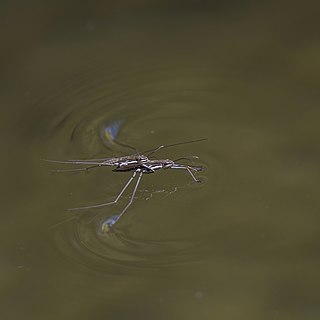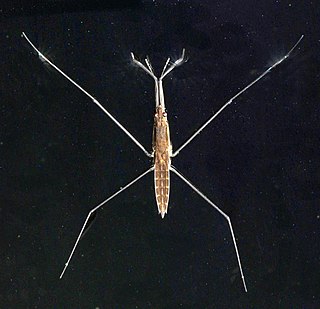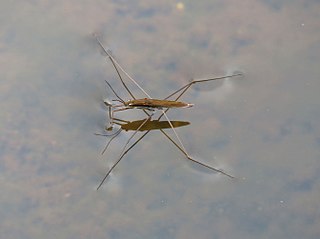
The Gerridae are a family of insects in the order Hemiptera, commonly known as water striders, water skeeters, water scooters, water bugs, pond skaters, water skippers, water gliders, water skimmers or puddle flies. Consistent with the classification of the Gerridae as true bugs, gerrids have mouthparts evolved for piercing and sucking, and distinguish themselves by having the unusual ability to walk on water, making them pleuston (surface-living) animals. They are anatomically built to transfer their weight to be able to run on top of the water's surface. As a result, one could likely find water striders present in any pond, river, or lake. Over 1,700 species of gerrids have been described, 10% of them being marine.

Nepomorpha is an infraorder of insects in the "true bug" order (Hemiptera). They belong to the "typical" bugs of the suborder Heteroptera. Due to their aquatic habits, these animals are known as true water bugs. They occur all over the world outside the polar regions, with about 2,000 species altogether. The Nepomorpha can be distinguished from related Heteroptera by their missing or vestigial ocelli. Also, as referred to by the obsolete name Cryptocerata, their antennae are reduced, with weak muscles, and usually carried tucked against the head.

The Peloridiidae or moss bugs are a family of true bugs, comprising eighteen genera and thirty-four species. They are small, ranging in length from 2 to 4 mm, rarely seen, peculiarly lumpy, flattened bugs found in Patagonia, New Zealand, eastern Australia, Lord Howe Island, and New Caledonia. Peloridiids are found amongst mosses and liverworts, commonly in association with southern beech forests. They have become known as moss bugs for their habit of feeding on mosses. Almost all Peloridiidae species are flightless, except one. Their present distribution suggests they have existed since before the breakup of Gondwana. They are the only living members of the suborder Coleorrhyncha, which first appeared in the Upper Permian, over 250 million years ago.
Paleontology or palaeontology is the study of prehistoric life forms on Earth through the examination of plant and animal fossils. This includes the study of body fossils, tracks (ichnites), burrows, cast-off parts, fossilised feces (coprolites), palynomorphs and chemical residues. Because humans have encountered fossils for millennia, paleontology has a long history both before and after becoming formalized as a science. This article records significant discoveries and events related to paleontology that occurred or were published in the year 1910.

Water treaders, the superfamily Mesovelioidea, are insects in the order Hemiptera, the true bugs. They are semiaquatic insects that live in moist and wet habitat and on wet plant matter in several types of aquatic habitat.

Halobates or sea skaters are a genus with over 40 species of water striders. Most Halobates species are coastal and typically found in sheltered marine habitats, but five live on the surface of the open ocean and only occur near the coast when storms blow them ashore. These are the only known truly oceanic, offshore insects. They are found in tropical and subtropical marine habitats around the world, with a single species recorded in rivers a few kilometers upstream from the ocean. Halobates are generally very common.

Coleorrhyncha or Peloridiomorpha, also known as moss bugs or beetle bugs, are a suborder of Hemiptera and represent an ancient lineage of moss-feeding insects. They show some similarities to the Heteroptera but have been considered distinct. It has a single extant family, the Peloridiidae. They are 2 to 5 millimetres in length, and feed on moss and liverworts. They have wings in some species which are reduced in others but all species are flightless and live in damp moss habitats and are associated with the distribution of Nothofagus trees in Australia, New Zealand, New Caledonia, and South America, which all were formerly part of the supercontinent Gondwana.

Aquarius remigis, known as the common water strider, is a species of aquatic bug. It was formerly known as Gerris remigis, but the subgenus Aquarius was elevated to generic rank in 1990 on the basis of phylogenetic analysis. Aquarius remigis is found throughout North America, but is most prevalent in the mid-west of the United States.

Aquarius najas, also known as the river skater, is a European species of water strider. It was formerly known as Gerris najas, but the subgenus Aquarius was elevated to generic rank in 1990 on the basis of phylogenetic analysis.

Gerrini is a tribe of water striders containing over 160 species in 12 genera.

Gerris is a bug genus in the family Gerridae.

Aquarius is a genus of water striders found predominantly in the northern hemisphere. Formerly a subgenus, Aquarius was elevated to generic rank in 1990 on the basis of phylogenetic analysis. These are among the world's largest water striders, with females averaging 12–17 mm (0.47–0.67 in) long and males roughly 10–30% smaller, depending on the exact species. An outlier is A. elongatus where both sexes typically are about 24 mm (0.94 in), roughly the same as certain Cylindrostethus, and second only to Gigantometra gigas.

Tingini is a tribe of lace bugs in the family Tingidae. There are at least 250 genera and 2,400 described species in Tingini.

Tingis is a genus of lace bugs in the family Tingidae. There are at least 130 described species in Tingis.

Limnoporus is a genus of water striders in the family Gerridae. There are six extant described species in Limnoporus.
Cantacaderinae is a subfamily of lace bugs in the family Tingidae. There are about 16 genera and at least 90 described species in Cantacaderinae.

Aquarius conformis is a species of water strider in the family Gerridae. It is found in eastern North America from Quebec west to Wisconsin and south to Florida and Mexico.

Hermatobates is a genus of wingless marine bugs placed as the sole genus in the family Hermatobatidae that are sometimes known as coral-treaders. They are quite rare and known only from coral reefs in the Indo-Pacific region. During low tide, they move over the water surface not unlike the more familiar water-striders around coral atolls and reefs and stay submerged in reef crevices during high tide.

Aquarius nebularis is a species of water strider in the family Gerridae. It is found in the eastern United States from New York south to central Florida and west to Louisiana, Arkansas, and Iowa.















